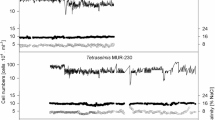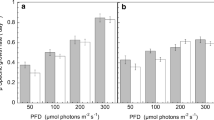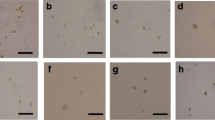Abstract
Natural saline lakes in Western Australia were sampled for microalgae species and strains with potential for large-scale outdoor cultivation over a wide range of salinities for biofuels production. Using a rational isolation and screening process, several Tetraselmis strains (Chlorophyta, Chlorodendrales) with a broad range of salinity tolerance were identified and were characterised further for their potential for biofuels production. Specific growth rates increased from 0.8 to 1.2 days−1 when the medium salinity was decreased from 11 to 3 % (w/v) NaCl (1.88 to 0.51 M NaCl) in batch cultivation mode, thereby indicating quick adaptation to large salinity changes. In general, ash-free dry weight (AFDW), total lipid, protein and carbohydrate contents per cell were highest in the early stages of growth. Salinity increases led to an increase in cell AFDW, with the highest mean maximum of 2555 ± 659 pg AFDW.cell−1 at 11 % (w/v) NaCl in the strains Tetraselmis MUR 167 and MUR 219 which had been in culture for many years, as compared to the mean maximum of 981 ± 141 pg AFDW.cell−1 the in newly isolated strains MUR 230, 231, 232 and 233. Similar observations on total lipid, protein and carbohydrate content per cell were made between the two groups of strains. Overall, all strains yielded high biomass and total lipid productivities over a very wide range of salinities without large variation in their gross biochemical composition and growth pattern. Based on AFDW and total lipid productivity data, the order of preference for selecting strains for further investigation for large-scale culture was MUR 231 > MUR 233 > MUR 219 > MUR 230 > MUR 232 > MUR 167. The Tetraselmis spp. were also very competitive as shown by the outdoor cultivation of diatom, Halamphora coffeaeformis MUR 158, in parallel with Tetraselmis sp. MUR 167 which resulted in the diatom being outcompeted by the green alga. Our results demonstrate the high commercial potential of euryhaline Tetraselmis spp. for cultivation over a broad range of salinity in outdoor cultures.





Similar content being viewed by others
References
Andersen RA, Kawachi M (2005) Traditional microalgae isolation techniques. In: Andersen RA (ed) Algal culturing techniques. Elsevier, Amsterdam, pp 83–100
Arora M, Anil AC, Leliaert F, Delany J, Mesbahi E (2013) Tetraselmis indica (Chlorodendrophyceae, Chlorophyta), a new species isolated from salt pans in Goa, India. Eur J Phycol 48:61–78
Barclay B, Nagle N, Terry K, Roessler P (1985) Collecting and screening microalgae from shallow, inland saline habitats. In: Aquatic Species Program review: Proceedings of the March 1985 Principal Investigators’ meeting, pp 52-68
Barclay W, Johansen J, Chelf P, Nagle N, Roessler P, Lemke P (1986) Microalgae culture collection 1986-1987. Golden, Colorado. Report SP-232-3079 pp 149
Barclay WR, Terry KL, Nagle NJ, Weissman JC, Goebel RP (1987) Potential of new strains of marine and inland saline-adapted microalgae for aquaculture. J World Aquacult Soc 18:218–228
Ben-Amotz A, Tornabene TG, Thomas WH (1985) Chemical profile of selected species of microalgae with emphasis on lipids. J Phycol 21:72–81
Borowitzka LJ (1981) The microflora. Adaptations to life in extremely saline lakes. Hydrobiologia 81:33–46
Borowitzka MA (2013) Strain selection. In: Borowitzka MA, Moheimani NR (eds) Algae for biofuels and energy. Springer, Dordrecht, pp 77–89
Borowitzka MA, Moheimani NR (2013) Sustainable biofuels from algae. Mitig Adaptat Strat Global Chang 18:13–25
Borowitzka MA, Siva CJ (2007) The taxonomy of the genus Dunaliella (Chlorophyta, Dunaliellales) with emphasis on the marine and halophilic species. J Appl Phycol 19:567–590
Brand LE (1981) Genetic variability in reproduction rates in marine phytoplankton populations. Evolution 35:1117–1127
Brearley A (2005) Understanding Swanland. In: Brearley A (ed) Ernest Hodgkin's Swanland. Estuaris and coastal lagoons of South-Western Australia. University of Western Australia Press, Perth, pp 1–68
Bunn SE, Edward DHD (1984) Seasonal meromixis in three hypersaline lakes on Rottnest Island, Western Australia. Aust J Mar Freshwat Res 35:261–265
Butcher RW (1959) An introductory account of the smaller algae of Britisch coastal waters. Part I. Introduction and Chlorophyceae. Fishery Investigations Series IV. HMSO, London
Carmelo RT, Grethe RH (1997) Identifying marine phytoplankton. Academic Press, San Diego
Clavero E, Hernández-Mariné M, Grimalt JO, Garcia-Pichel F (2000) Salinity tolerance of diatoms from thalassic hypersaline environments. J Phycol 36:1021–1034
Cooksey KE (1981) Requirement for calcium in adhesion of a fouling diatom to glass. Appl Environ Microbiol 41:1378–1382
Cooksey KE, Cooksey B (1986) Adhesion of fouling diatoms to surfaces: some biochemistry. In: Evans LV, Hoagland KD (eds) Algal biofouling. Elsevier, Amsterdam, pp 41–54
Dempster TA, Sommerfeld MR (1998) Effects of environmental conditions on growth and lipid accumulation in Nitzschia communis (Bacillariophyceae). J Phycol 34:712–721
Dickson DMJ, Kirst GO (1986) The role of β-methylsulphoniopropionate, glycine betaine and homarine in the osmoacclimation of Platymonas subcordiformis. Planta 167:536–543
Dorsey TE, McDonald P, Roels OA (1978) Measurements of phytoplankton-protein content with the heated Biuret-Folin assay. J Phycol 14:167–171
Dunstan GA, Volkman JK, Jeffrey SW, BArrett SM (1992) Biochemical composition of microalgae from the green algal classes Chlorophyceae and Prasinophyceae.2. Lipid classes and fatty acids. J Exp Mar Biol Ecol 161:115–134
Fábregas J, Herrero C, Abalde J, Cabezas B (1985) Growth, chlorophyll a and protein of the marine microalga Isochrysis galbana in batch cultures with different salinities and high nutrient concentrations. Aquaculture 50:1–11
Fábregas J, Otero A, Morales E, Cordero B, Patiño M (1996) Tetraselmis suecica cultured in different nutrient concentrations varies in nutritional value to Artemia. Aquaculture 143:197–204
Falkowski PG, Owens TG (1980) Light-shade adaptation: two strategies in marine phytoplankton. Plant Physiol 66:592–595
Ferreira M, Coutinho P, Seixas P, Fábregas J, Otero A (2009) enriching rotifers with “premium” microalgae. Nannochloropsis gaditana. Mar Biotechnol 11:585–595
Folch J, Lees M, Sloane Stanley GH (1957) A simple method for the isolation and purification of total lipids from animal tissues. J Biol Chem 226:497–509
Fon Sing S (2011) Strain selection and outdoor ciltivation of halophilic microalgae with potential for large-scale biodiesel production. PhD Thesis, Murdoch University, Perth
Fon Sing S, Isdepsky A, Borowitzka MA, Moheimani NR (2013) Production of biofuels from microalgae. Mitig Adapt Strat Global Chang 18:47–72
Fon Sing S, Isdepsky A, Borowitzka MA, Lewis DM (2014) Pilot-scale continuous recycling of growth medium for the mass culture of a halotolerant Tetraselmis sp. in raceway ponds under increasing salinity: a novel protocol for commercial microalgal biomass production. Bioresour Technol 161:47–54
Geesey GG, Wigglesworth-Cooksey B, Cooksey KE (2000) Influence of calcium and other cations on surface adhesion of bacteria and diatoms: a review. Biofouling 15:195–205
Griffiths M, Harrison S (2009) Lipid productivity as a key characteristic for choosing algal species for biodiesel production. J Appl Phycol 21:493–507
Gröne T, Kirst GO (1992) The effect of nitrogen deficiency, methionine and inhibitors of methionine metabolism on the DMSP contents of Tetraselmis subcordiformis (Stein). Mar Biol 112:497–503
Guillard RRL, Ryther JH (1962) Studies of marine planktonic diatoms.I. Cyclotella nana Hustedt and Detonula confervacea (Cleve) Gran. Can J Microbiol 8:229–239
Hammer UT (1981) Primary production in saline lakes. Hydrobiologia 81:47–57
Hellebust JA (1976) Effect of salinity on photosynthesis and mannitol synthesis in the green flagellate Platymonas suecica. Can J Bot 54:1735–1741
Hodgkin EP (1959) The salt lakes of Rottnest Island. J R Soc West Aust 42:84–85
Jiménez C, Cossío BR, Labella D, Xavier Niell F (2003) The feasibility of industrial production of Spirulina (Arthrospira) in southern Spain. Aquaculture 217:179–190
John J (1983) The diatom flora of the Swan River estuary, Western Australia. J. Cramer, Vaduz
Kawabata Y, Nakahara H, Katayama Y, Ishida N (1997) The phytoplankton of some saline lakes in Central Asia. Int J Salt Lake Res 6:5–16
Khatoon H, Abdu Rahman N, Banerjee S, Harun N, Suleiman SS, Zakaria NH, Lananan F, Abdul Hamid SH, Endut A (2014) Effects of different salinities and pH on the growth and proximate composition of Nannochloropsis sp. and Tetraselmis sp. isolated from South China Sea cultured under control and natural condition. Int Biodeterior Biodegrad 95:11–18
Kirst G (1977a) Ion composition of unicellular marine and fresh-water algae, with special reference to Platymonas subcordiformis cultivated in media with different osmotic strengths. Oecologia 28:177–189
Kirst GO (1977b) Coordination of ionic relations and mannitol concentrations in the euryhaline unicellular alga, Platymonas subcordiformis (Hazen) after osmotic shocks. Planta 135:69–75
Kirst GO (1988) Accumulation of organic compounds with increasing salinity:mannitol accumulation in the unicellular phytoplankter Platymonas. In: Lobban CS, Chapman DJ, Kremer BP (eds) Experimental phycology. Cambridge Univeristy Press, Cambridge, pp 217–223
Kirst GO, Keller HJ (1976) Der Einfluss unterschiedlicher NaCl-Konzentrationen auf die Atmung der einzelligen Alge Platymonas subcordiformis Hazen. Bot Mar 19:241–244
Kochert G (1978) Carbohydrate determined by the phenol-sulphuric acid method. In: Hellebust JA, Craigie JS (eds) Handbook of phycological methods. Physiological and biochemical methods. Volume 2. Cambridge University Press, Cambridge, pp 95–97
Lakeman MB, von Dassow P, Cattolico RA (2009) The strain concept in phytoplankton ecology. Harmful Algae 8:746–758
Lewin JC (1966) Silicon metabolism in diatoms. V. Germanium dioxide, a specific inhibitor of diatom growth. Phycologia 6:1–12
López-González PJ, Guerrero F, Carmen Castro M (1998) Seasonal fluctuations in the plankton community in a hypersaline temporary lake (Honda, southern Spain). Int J Salt Lake Res 6:353–371
Lowry OH, Rosebrough NJ, Farr AL, Randall RJ (1951) Protein measurement with the folin phenol reagent. J Biol Chem 193:265–275
Mercz TI (1994) A study of high lipid yielding microalgae with potential for large-scale production of lipids and polyunsaturated fatty acids. PhD thesis, Murdoch University, Perth
Moheimani NR, Borowitzka MA, Isdepsky A, Fon Sing S (2013) Standard methods for measuring growth of algae and their composition. In: Borowitzka MA, Moheimani NR (eds) Algae for biofuels and energy. Developments in Applied Phycology 5. Springer Science+Business Media, Dordrecht, pp 265-284
Okauchi M, Kawamura K (1997) Optimum medium for large-scale culture of Tetraselmis tetrathele. Hydrobiologia 358:217–222
Pate R, Klise G, Wu B (2011) Resource demand implications for US algae biofuels production scale-up. Appl Energy 88:3377–3388
Pusceddu A, Fabiano M (1996) Changes in the biochemical composition of Tetraselmis Suecica and Isochrysis galbana during growth and decay. Chem Ecol 12:199–212
Regan DL (1988) Other micro-algae. In: Borowitzka MA, Borowitzka LJ (eds) Micro-algal biotechnology. Cambridge University Press, Cambridge, pp 135–150
Regan D, Ivancic N (1984) Mixed populations of marine microalgae in continuous culture: factors affecting species dominance and biomass productivity. Biotechnol Bioeng 26:1265–1271
Reitan KI, Rainuzzo JR, Olsen Y (1994) Effect of nutrient limitation on fatty acid and lipid content of marine microalgae. J Phycol 30:972–979
Renaud S, Parry D (1994) Microalgae for use in tropical aquaculture II: effect of salinity on growth, gross chemical composition and fatty acid composition of three species of marine microalgae. J Appl Phycol 6:347–356
Resurreccion EP, Colosi LM, White MA, Clarens AF (2012) Comparison of algae cultivation methods for bioenergy production using a combined life cycle assessment and life cycle costing approach. Bioresour Technol 126:298–306
Richardson K, Beardall J, Raven JA (1983) Adaptation of unicellular algae to irradiance: an analysis of strategies. New Phytol 93:157–191
Rodolfi L, Zittelli GC, Bassi N, Padovani G, Biondi N, Bonini G, Tredici MR (2009) Microalgae for oil: strain selection, induction of lipid synthesis and outdoor mass cultivation in a low-cost photobioreactor. Biotechnol Bioeng 102:100–112
Round FE, Crawford RM, Mann DG (1990) The diatoms: biology and morphology of the genera. Cambridge University Press, Cambridge
Ryther JH (1956) Photosynthesis in the ocean as a function of light intensity. Limnol Oceanogr 1:61–70
Sheehan J, Dunahay T, Benemann J, Roessler P (1998) A look back at the U.S Department of Energy's Aquatic Species Program: biodiesel from algae. National Renewable Energy Laboratory,. Golden, Colorado. NREL/TP-580-24190 pp 1-328
Sigaud TCS, Aidar E (1993) Salinity and temperature effects on the growth and chlorophyll-a content of some planktonic algae. Bol Inst Oceanogr S Paulo 41:95–103
Strizh IG, Popova LG, Balnokin YV (2004) Physiological aspects of adaptation of the marine microalga Tetraselmis (Platymonas) viridis to various medium salinity. Russ J Plant Physiol 51:176–182
Thomas WH, Tornabene TG, Weissman JC (1984) Screening for lipid yielding microalgae: activities for 1983. Golden, Colorado. SERI/ STR-231-2207 pp 44
Van den Hoek C, Mann DG, Jahns HM (1995) Algae. An introduction to phycology. Cambridge University Press, Cambridge
Vonshak A (1987) Strain selection of Spirulina suitable for mass production. Hydrobiologia 151–152:75–77
Vonshak A, Richmond A (1981) Photosynthetic and respiratory activity in Anacystis nidulans adapted to osmotic stress. Plant Physiol 68:504–505
Walach MR, Pirt SJ (1986) The growth and adhesion to glass of algal (Chlorella) cells: the effects of iron and other mineral nutrients. Appl Microbiol Biotechnol 24:468–470
Weissman JC, Goebel RP (1986) Factors affecting the photosynthetic yield of micro-algae. Golden, Colorado. SERI/SP-231-3071 pp 139-168
Wijffels RH, Barba E (2010) An outlook on microalgal biofuels. Science 329:796–799
Wikfors GH, Patterson GW, Ghosh P, Lewin RA, Smith BC, Alix JH (1996) Growth of post-set oysters, Crassostrea virginica, on high-lipid strains of algal flagellates Tetraselmis spp. Aquaculture 143:411–419
Yang J, Xu M, Zhang X, Hu Q, Sommerfeld M, Chen Y (2011) Life-cycle analysis on biodiesel production from microalgae: water footprint and nutrients balance. Bioresour Technol 102:159–165
Acknowledgments
S. Fon Sing received a PhD Scholarship from Murdoch University. We thank Mr. Torsten Geiβler for his contribution in the field work and Ms. Julia Sgonina for her collaboration in the biochemical analyses. The right to all intellectual property for Tetraselmis sp. strains MUR 167, 230 and 233, including methods for reliable high productivity culturing, has been assigned to Muradel Pty Ltd.
Author information
Authors and Affiliations
Corresponding author
Rights and permissions
About this article
Cite this article
Fon-Sing, S., Borowitzka, M.A. Isolation and screening of euryhaline Tetraselmis spp. suitable for large-scale outdoor culture in hypersaline media for biofuels. J Appl Phycol 28, 1–14 (2016). https://doi.org/10.1007/s10811-015-0560-2
Received:
Revised:
Accepted:
Published:
Issue Date:
DOI: https://doi.org/10.1007/s10811-015-0560-2




